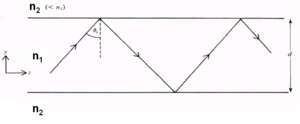Difference between revisions of "Planar Dielectric Waveguides"
Jump to navigation
Jump to search
Cmditradmin (talk | contribs) |
Cmditradmin (talk | contribs) |
||
| Line 13: | Line 13: | ||
The waveguide consists of a semi-infinite slab of dielectric materials with thickness d and refractive index n1 (the core) that is sandwiched between two regions (the cladding) both of refractive index n2, and where n1>n2. | The waveguide consists of a semi-infinite slab of dielectric materials with thickness d and refractive index n1 (the core) that is sandwiched between two regions (the cladding) both of refractive index n2, and where n1>n2. | ||
[[Image:Waveguide_onebeam.png|thumb|300px|A beam propagating down a waveguide within the core layer]] | |||
A ray of light may propagate down the core provided that total internal reflection occurs at the core/cladding interface. | A ray of light may propagate down the core provided that total internal reflection occurs at the core/cladding interface. | ||
Revision as of 15:48, 6 August 2009
| Previous Topic | Return to Optical Fibers, Waveguides, and Lasers Menu | Next Topic |
Planar dielectric waveguides
Planar (slab) waveguides are the basis of waveguides used in integrated optoelectronics. The same mathematical ideas can be applied (with minor modifications) to circular waveguides.
The waveguide consists of a semi-infinite slab of dielectric materials with thickness d and refractive index n1 (the core) that is sandwiched between two regions (the cladding) both of refractive index n2, and where n1>n2.
A ray of light may propagate down the core provided that total internal reflection occurs at the core/cladding interface.
this requires that:
- <math>90\deg >\theta_i > \theta_c\,\!</math>
Where
- <math>\theta_i\,\!</math> is the internal ray angle (from now on written as theta)

